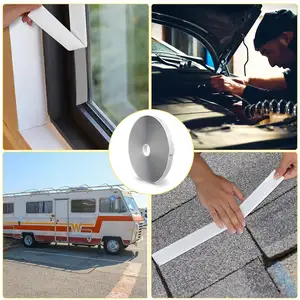

Modern Fire Waterproof ASA Synthetic Resin Roof Tiles Color Corrugated Resin Roof Sheet Insulated Roofing Shingles

Leak Multi Use Outdoor Waterproof Leak Repair And Seal Strip RV Window Pipe Metal Awning Roof Seal Boat Outdoor Use Butyl Tape























Roof seal is a type of coating that is applied to the surface of a roof to protect it from the elements. The main purpose of the roof seal is to create a barrier that prevents water from seeping into the roof and causing damage.
Roof sealant comes in different types, including acrylic, silicone, and butyl, and each type has its advantages and disadvantages. It is important to choose a roof seal based on the climate, building type, and budget for the project. Silicone roof seal is highly durable and can withstand extreme temperatures. These materials are also resistant to UV rays and can last up to 20 years. However, they tend to be more expensive than other types of roof sealant. On the other hand, acrylic roof seal is more affordable than silicone sealant and easy to apply. Acrylic sealant is also resistant to UV rays and can last up to 10 years, but it is more prone to cracking and peeling.
Another type of roof sealant spray is butyl, or rubber roof sealant. Butyl sealants are highly flexible and can be used on various surfaces, including metal, wood, and concrete. Although butyl sealants are versatile, they are not well-suited to extreme climates. Finally, asphalt roof sealants are one of the most affordable and easy to apply. Asphalt roof seal can last approximately ten years but is not as resistant to UV rays and tends to become brittle over time.
For minor projects, roof seal tape is a type of adhesive tape designed to seal small air and water leaks. It is typically made of a flexible material such as butyl rubber or silicone and is often used to repair leaks or seal joints in roofs. Roof seal tape is usually applied to the roof surface after it has been cleaned and dried and can also be used to seal around pipes, vents, and other roof penetrations.
Roof sealant is crucial to maintaining a healthy and secure home. Not only does roof sealant help prevent water damage and leaks, but it also helps regulate the temperature inside the home by preventing air drafts and reducing heat loss. In warmer regions, roof seal reduces the temperature of the roof outside, which can result in lower energy costs for cooling the building. Finally, roof sealant can help prolong the life of the roof by preventing damage from UV rays and other environmental factors. Without proper sealing, a roof can be vulnerable to water damage, mold growth, and other structural issues.